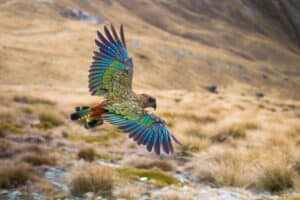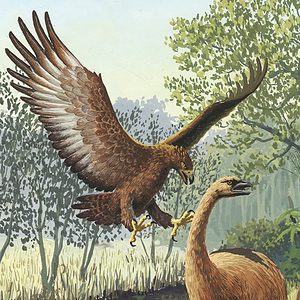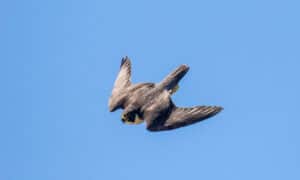Over half of the bird species from the United States are found in Texas. This state has diverse habitats, geography, and climates that make it one of the best birding destinations in the country. You can find many beautiful birds, native or migratory, including finches. These colorful birds are enticed by fresh black seeds, bird baths, bright ribbons, and place feeders near trees. Discover the 11 types of finches in Texas and learn to identify them with this handy picture and ID guide.
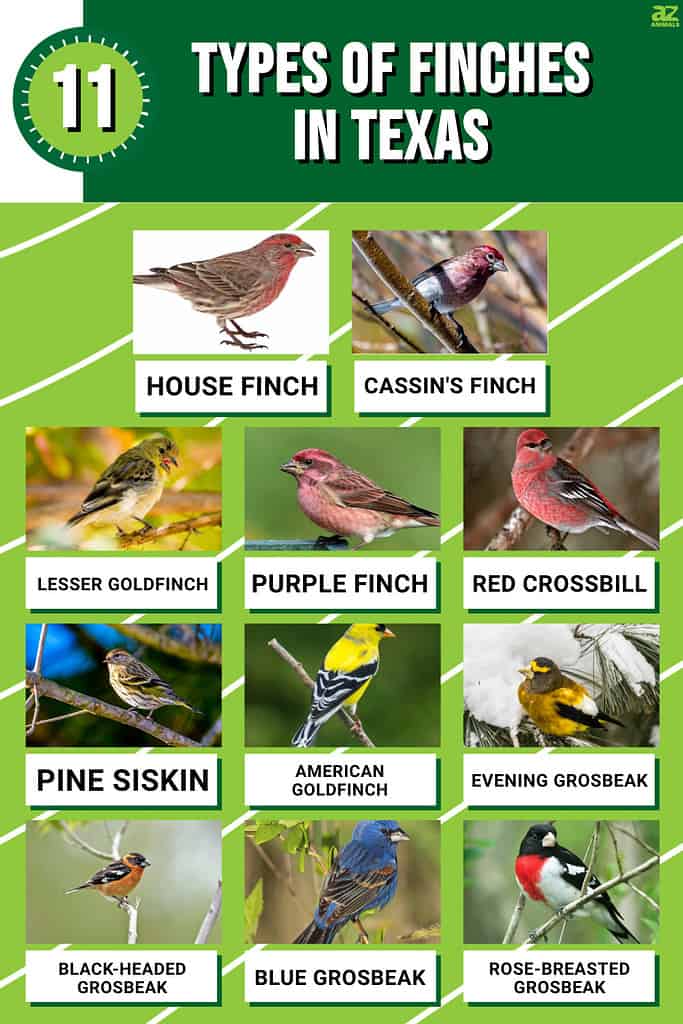
1. House Finch (Haemorhous mexicanus)
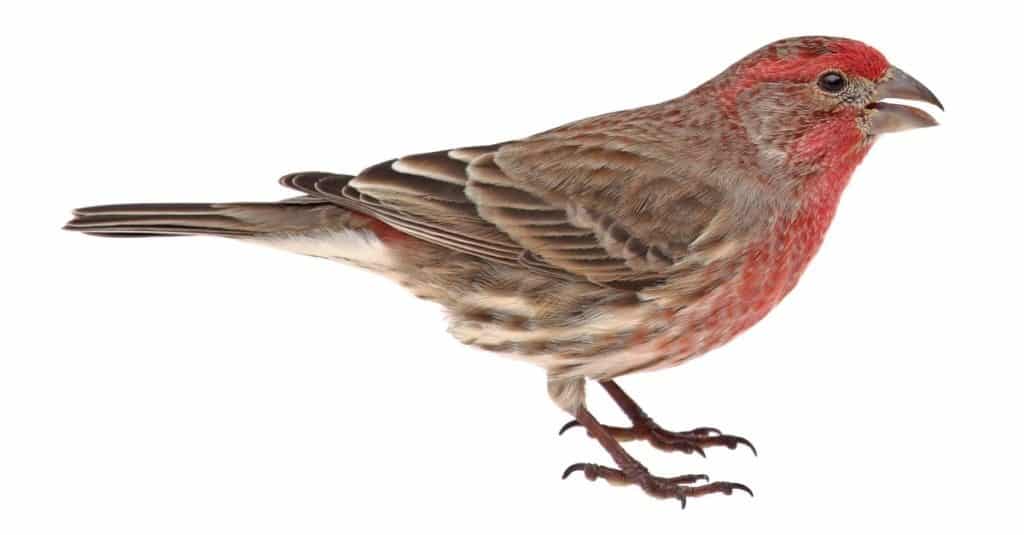
The house finch is abundant in the Panhandle, Central, and West Texas.
©Charles Brutlag/Shutterstock.com
| Length | 5.1 – 5.5 inches |
| Weight | 0.6 – 0.9 ounces |
| Wingspan | 7.9 – 9.8 inches |
| Male | Rosy red face and breast with brown streaky back and tail |
| Female | Plain grayish-brown |
| Status in Texas | Year-round |
The house finch inhabits most areas in Texas, but primarily the Panhandle, Central, and West Texas. This colorful, adaptable bird is native to the Southwest. Its rosy, red face is a common sight in backyards across the United States. When it is not at feeders, you can find it on the ground or perched high in nearby trees. Its native habitats are deserts, grasslands, and open woods, but it also frequents backyards, parks, and farms. The house finch eats mainly vegetable matter, like seeds, buds, and berries. It is also one of the easiest birds to attract. It enjoys plenty of water, tube feeders with resting places, and black sunflower seeds.
2. Cassin’s Finch (Haemorhous cassinii)
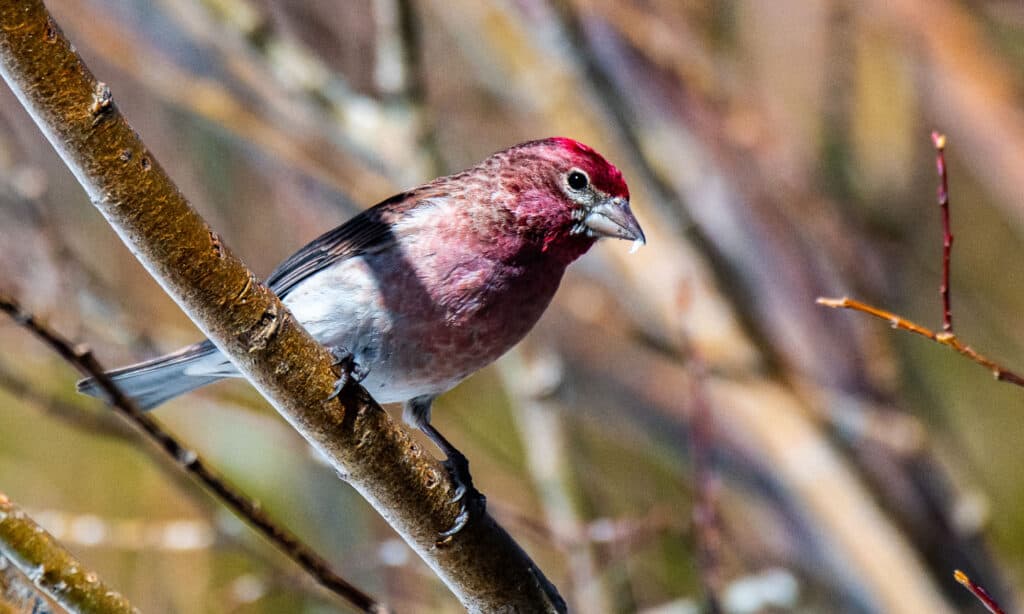
Look for the Cassin’s finch in West Texas mountain habitats during winter.
©Kerry Hargrove/Shutterstock.com
| Length | 6.3 inches |
| Weight | 0.8 – 1.2 ounces |
| Wingspan | 9.8 – 10.6 inches |
| Male | Rosy pink overall with a bright red crown |
| Female | Brown and white with dark streaks |
| Status in Texas | Winter, uncommon |
The Cassin’s finch is not common in the state, but you may spot one during the winter in western Texas. This bird is similar to the purple finch, except it’s slightly bigger with a longer bill. In western North America, you can find it in mountains and conifer forests. They stay in high elevations during summer but move to lower elevations during winter. They feed on pine seeds and tree buds, along with berries and insects during the warmer months. The male’s song can be confusing, as he imitates other birds, but listen for his sweet “tulip” notes.
3. Lesser Goldfinch (Spinus psaltria)
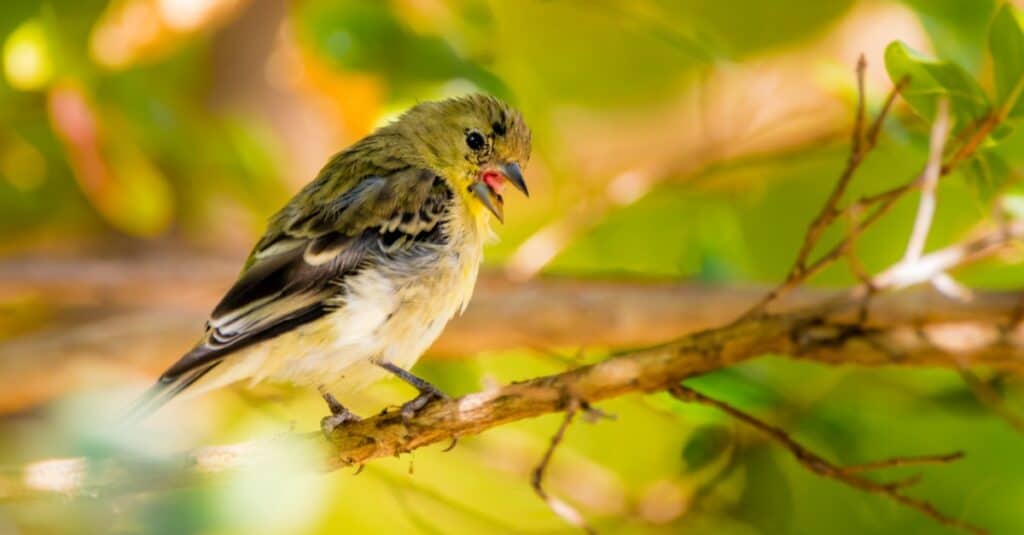
The lesser goldfinch is abundant in the Guadalupe Valley of Edward’s Plateau.
©iStock.com/Sunil Singh
| Length | 3.5 – 4.3 inches |
| Weight | 0.3 – 0.4 ounces |
| Wingspan | 5.9 – 7.9 inches |
| Male | Bright yellow undersides and glossy black backs with white patches on their wings |
| Female | Dull yellow undersides and olive backs with black wings |
| Status in Texas | Year-round |
The lesser goldfinch lives year-round in Texas, mainly in the Central and Southwest portions of the state. There is an abundant population in the Guadalupe Valley of Edward’s Plateau. These tiny finches are brightly colored but may be easily overlooked. Their call notes consist of rapid twittering. They breed in lightly wooded areas with bald cypress and American sycamore trees near rivers and streams. They are known for gathering in groups of several hundred, feeding on seeds and grains in weedy fields. Attract this species by planting seed-producing plants like asters, sunflowers, and thistles. Some bird enthusiasts swear adding bright pops of yellow color around your yard and patio will captivate them.
4. Purple Finch (Haemorhous purpureus)
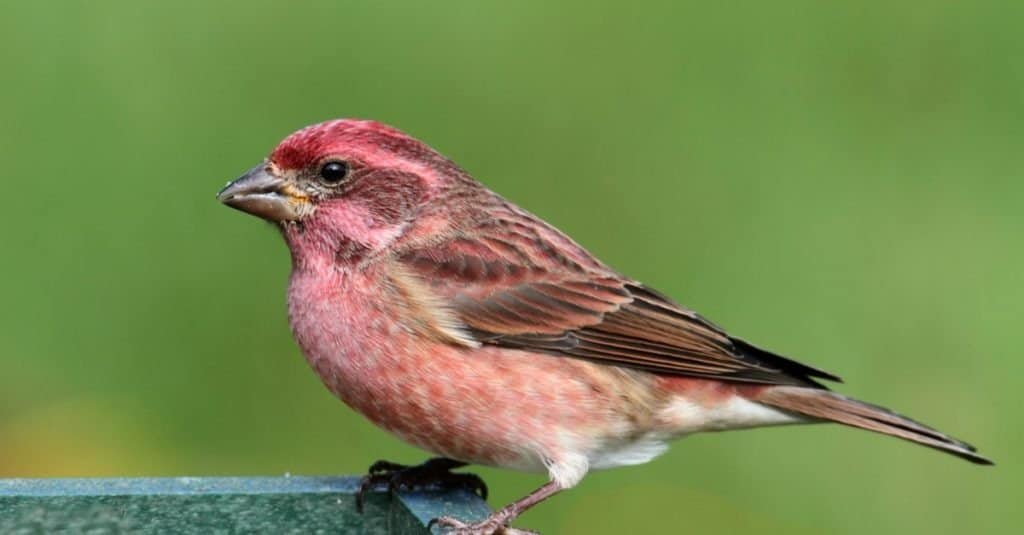
Purple finches occasionally migrate to Central and East Texas during winter.
©Steve Byland/Shutterstock.com
| Length | 4.7 – 6.3 inches |
| Weight | 0.6 – 1.1 ounces |
| Wingspan | 8.7 – 10.2 inches |
| Male | Pinkish-red head and breast mixing with brown on the back and a white underbelly. |
| Female | No red, with course brown streaks on the face, back, and underbelly |
| Status in Texas | Winter, uncommon |
These chunky purple birds occasionally migrate to Central and East Texas regions during the winter. The purple finch is technically a pinkish-red color. Despite being loud, it is hard to spot, as it stays high in the trees. Purple finches breed in coniferous forests, and during winter, you can find them in shrublands, fields, forest edges, and backyards. These birds enjoy feeders with black sunflower seeds and eat a varied diet of buds, berries, seeds, and insects. Purple finches are pleasant backyard companions due to the low, rich melodies they happily belt out from the treetops. These birds are more likely to visit if you have evergreen and pine trees, bird baths, and salt sources.
5. Red Crossbill (Loxia curvirostra)
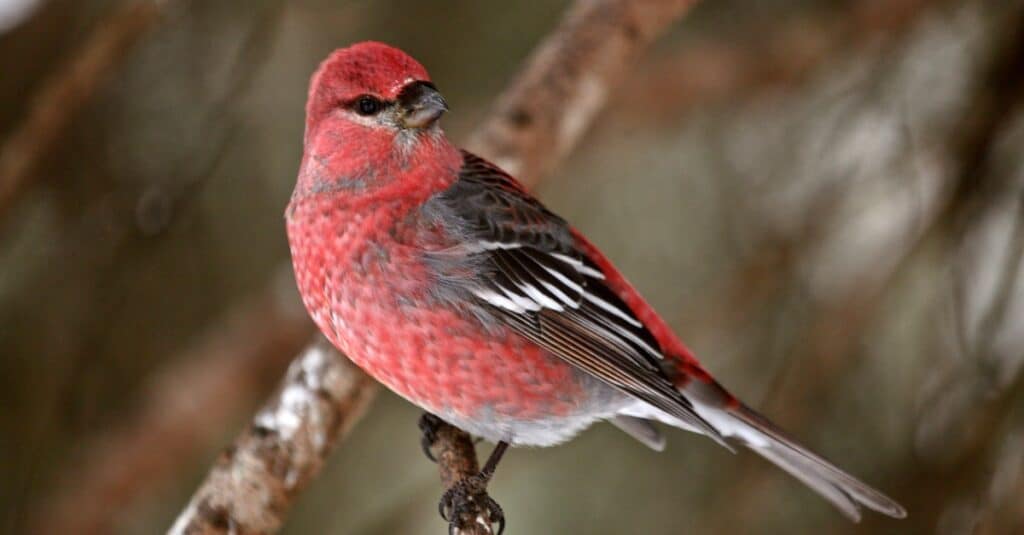
The red crossbill periodically makes its way from West Texas to East Texas.
©iStock.com/bobloblaw
| Length | 5.5 – 7.9 inches |
| Weight | 1.4 ounces |
| Wingspan | 10 – 10.75 inches |
| Male | Brick red overall with dark wings and tail |
| Female | Yellowish undersides with olive-brown backs |
| Status in Texas | Winter, uncommon |
Red crossbills are unique due to their variations in size and features, and researchers believe there are at least eight different species of the red crossbill. These stubby nomads are a rare sight in the Lone Star State but will periodically migrate from West Texas through East Texas during the winter. They’re easily recognizable by their sharp “Kip-Kip” calls as they fly over coniferous forests in the mountains, except for when they pass off course through the backyards and towns of Southern states. They may occasionally eat from feeders but typically forage from tree to tree with their flocks. The best way to attract these birds to your yard is by adding platform feeders filled with sunflower, nut, and fruit seed blends.
6. Pine Siskin (Spinus pinus)
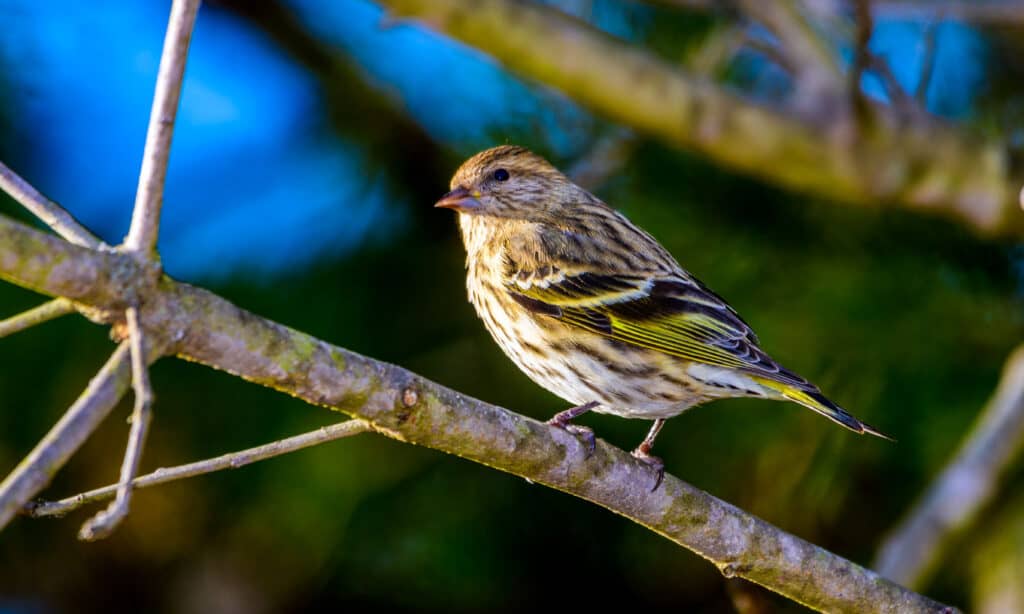
The pine siskin erratically migrates through Texas during the winter.
©Jeff W. Jarrett/Shutterstock.com
| Length | 4.3 – 5.5 inches |
| Weight | 0.4 – 0.6 ounces |
| Wingspan | 7.1 – 8.7 inches |
| Male | Streaky brown with yellow edges on wings and tail |
| Female | Nearly identical |
| Status in Texas | Winter, uncommon |
Pine siskins’ winter occurrence in Texas is erratic. In some years, they are abundant throughout the state; in other years, you may have difficulty finding them. On unpredictable occasions, they might fly through Texas during the winter, where you can see them at backyard feeders with thistle or Nyjer seed. If you want these birds in your backyard, try mimicking their natural habitat by placing feeders near large conifers and twiggy trees. More than likely, you can witness them foraging on the tips of branches in tight flocks, talking incessantly to each other (they have a distinctive slurp call). They live in evergreen and deciduous forests, where they eat seeds, vegetable matter, and insects.
7. American Goldfinch (Spinus tristis)
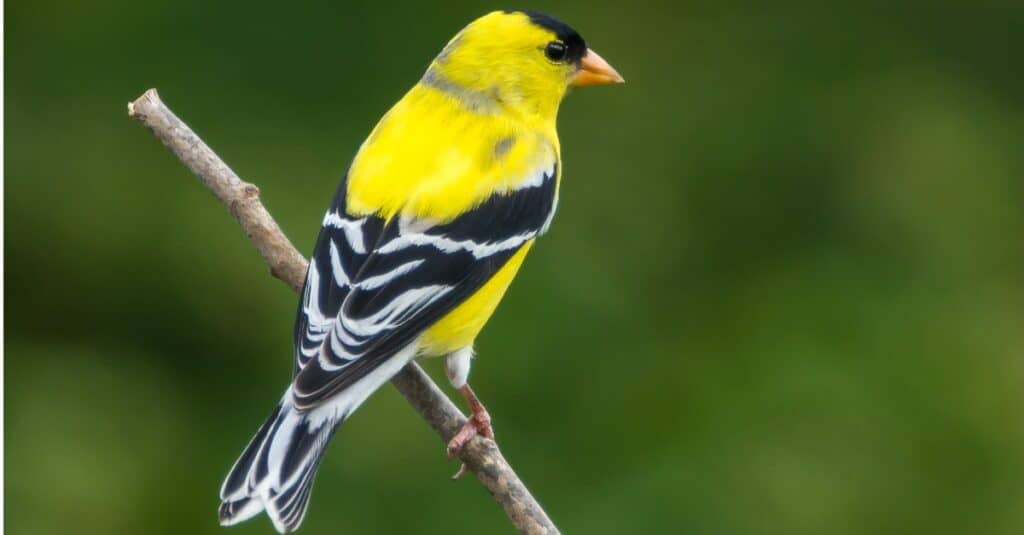
The American goldfinch is common throughout Texas during the colder months.
©iStock.com/impr2003
| Length | 4.3 – 5.1 inches |
| Weight | 0.4 – 0.7 ounces |
| Wingspan | 7.5 – 8.7 inches |
| Male | Bright yellow with a black forehead and wings with white markings |
| Female | Olive backs and a dull yellow underside |
| Status in Texas | Winter, common |
The goldfinch is common throughout most of Texas during winter, but its color will be a more subtle brown. While Texas residents may not see the American goldfinch in all its yellow glory during summer, they can still view this beautiful bird in its winter wear. You will find goldfinches traveling in flocks and congregating on weedy fields and feeders. They make their calls in flight and call attention to their energetic flying patterns. Their calls are distinguishable and sound like they are saying “potato chip,” with an even cadence. You can frequently see them at feeders during the colder months, and they enjoy dining on seeds from daisies, weeds, grasses, and trees. Goldfinches love to nibble on Nyjer and sunflower seeds and will return to your yard if you replace uneaten seeds every three to four weeks.
8. Evening Grosbeak (Hesperiphona vespertinus)
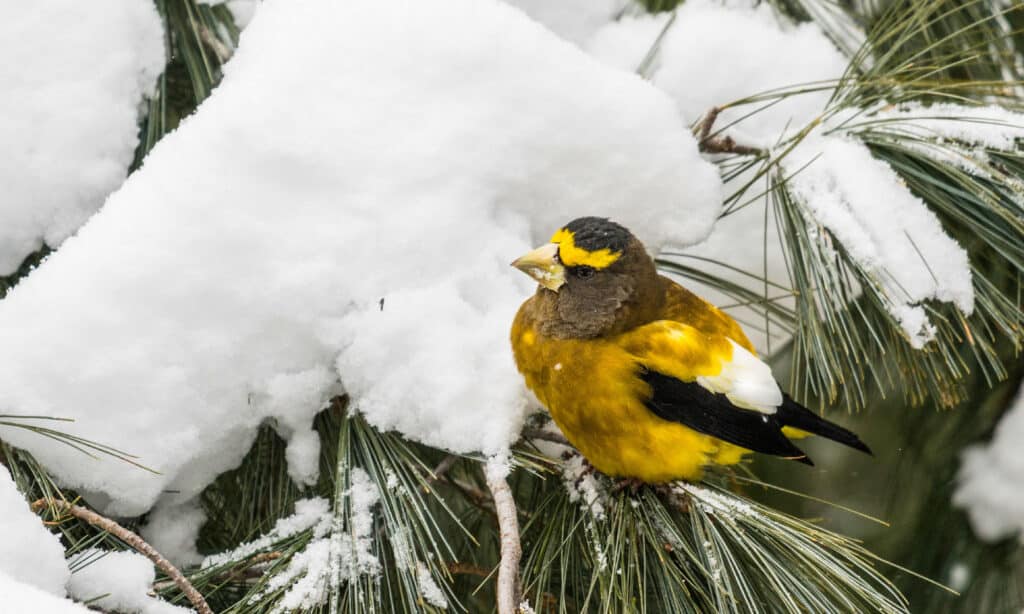
The evening grosbeak sporadically migrates through Texas during winter, eating at backyard feeders.
©Guoqiang Xue/Shutterstock.com
| Length | 6.3 – 7.1 inches |
| Weight | 1.9 – 2.6 ounces |
| Wingspan | 11.8 – 14.2 inches |
| Male | Yellow and black with white patches on the wings and bright yellow stripes over the eyes |
| Female | Mostly gray with white and black wings and a greenish-yellow tinged neck |
| Status in Texas | Winter, uncommon |
These colorful, big-billed finches are rare to sight in Texas, but they will sporadically find their way through the state, following a relatively straight line from West to East. You may commonly see them in backyard feeders, but further in the wild, they reside in coniferous and deciduous forests at high elevations. During the cold winter, they gather in flocks, foraging in treetops for seeds, berries, and small fruit. Their calls are similar to a house sparrow, except louder, short, musical whistles. If you want these finches in Texas to grace your backyard space, consider placing black oil sunflower seeds on a platform feeder.
9. Black-Headed Grosbeak (Pheucticus melanocephalus)
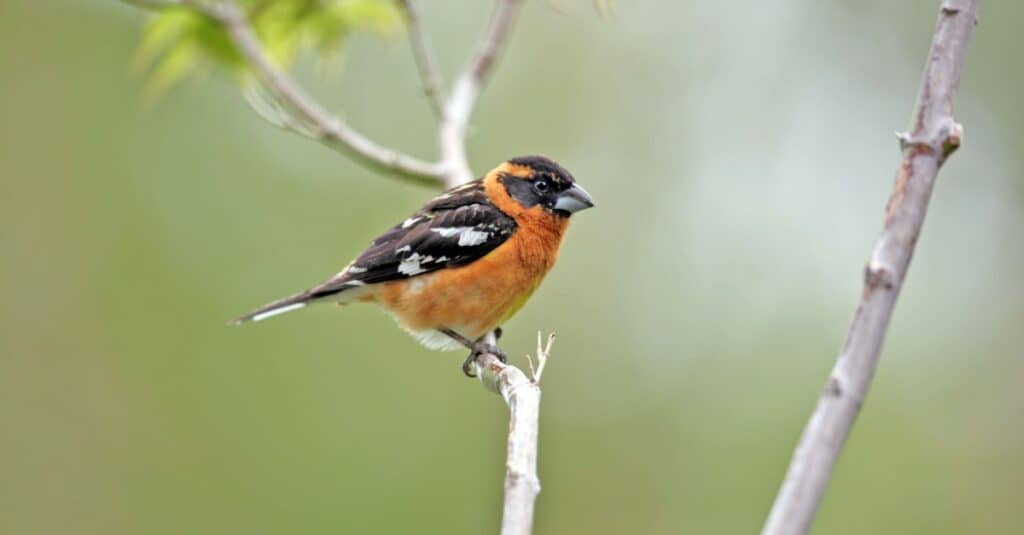
The black-headed grosbeak migrates through the Eastern half of Texas before breeding further north.
©iStock.com/ltterry
| Length | 7.1 – 7.5 inches |
| Weight | 1.2 – 1.7 ounces |
| Wingspan | 12.6 inches |
| Male | Rich orange with a black head and black and white wings |
| Female | Brown backs with orange breasts, gray bills, and bright yellow under the wings |
| Status in Texas | Migration |
Black-headed grosbeaks migrate through the Eastern half of Texas, and you can view them as they make their way north to breed. In spring, you can hear the males sing in their sweet, rich warble, making it easy for you to locate them. Look for the bright yellow underwings of the females as they fly overhead. This species has a varied habitat and can thrive in mixed woodlands, mountain forests, desert streams, and backyard gardens. They may be hard to spot as they hop through dense foliage, looking for food like insects, seeds, and berries. You can attract this rich orange bird by placing a hopper-type seed feeder near good perching spaces.
10. Blue Grosbeak (Passerina caerulea)
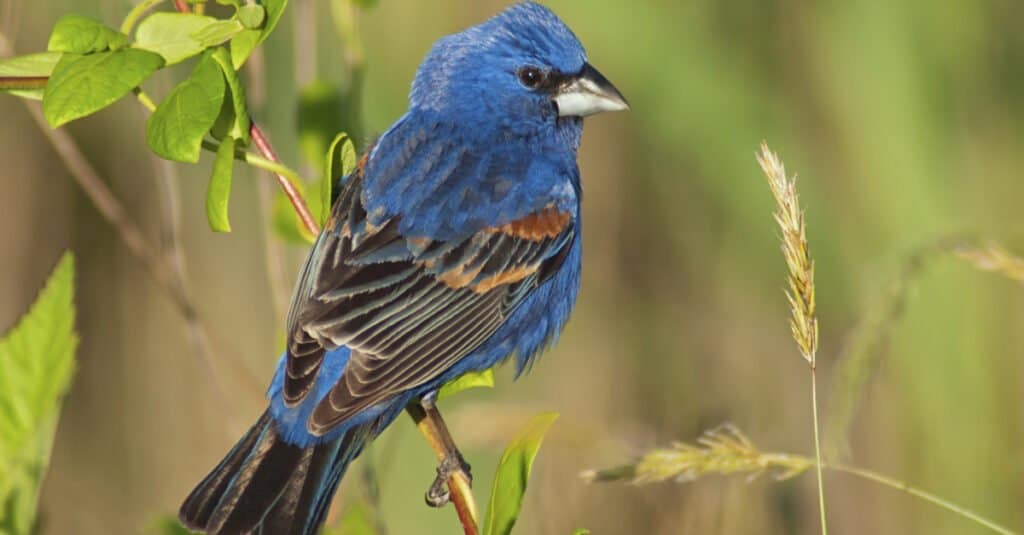
Blue grosbeaks are common in Texas during the breeding season in the spring and summer.
©Michael G. Mill/Shutterstock.com
| Length | 5.9 – 6.3 inches |
| Weight | 0.9 – 1.1 ounces |
| Wingspan | 11 inches |
| Male | Deep blue with chestnut wing bars and a black and silver beak |
| Female | Cinnamon brown with bluish tails |
| Status in Texas | Breeding, common |
Blue grosbeaks are common throughout all of Texas during the breeding season during spring and summer. While discreet, these birds have a deep blue color and twitch their tail sideways. Their loud, metallic clink sounds are familiar in Southern states during warm months as they perch themselves among thickets. In Texas, they often breed in areas with shrubs and a few tall trees or vegetation along waterways. Like all finches, they eat seeds and insects, increasing their intake of beetles, caterpillars, and other insects during the summer. Like most finches, blue grosbeaks are attracted to yards with shrubs, sturdy feeders, berries, and black oil sunflower seeds.
11. Rose-Breasted Grosbeak (Pheucticus ludovicianus)
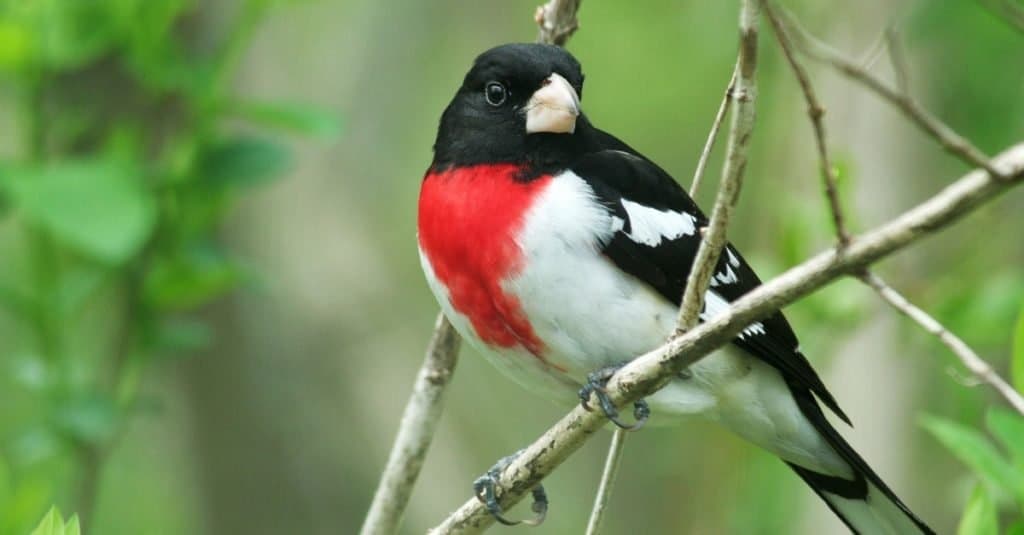
The rose-breasted grosbeak migrates through Central and East Texas in late spring.
©Jayne Gulbrand/Shutterstock.com
| Length | 7.1 – 8.7 inches |
| Weight | 1.2 – 2.3 ounces |
| Wingspan | 11.4 – 13 inches |
| Male | Black and white with a bright red chevron running down its chest |
| Female | Brown and heavily streaked with white stripes over the eyes |
| Status in Texas | Migration |
Rose-breasted grosbeaks migrate through the Central and Eastern portions of Texas late in the spring as they head north to breed. These birds stay out of sight in the treetops in leafy woodlands and can often be seen in fruiting trees during migration, which helps fuel their long journey. In the spring and summer, you can hear the soft melodies of rose-breasted grosbeaks, which sound similar to an American robin. Their other calls resemble a squeaking shoe with short, sharp, penetrating “eek-eeks.” You can attract these finches in Texas by planting plenty of insect-loving vegetation and providing large tube feeders filled with black oil sunflower seeds.
Summary of 11 Types of Finches in Texas with Pictures and ID Guide
Here’s a recap of the types of finches present in the state of Texas:
| Finch | Length | Weight | Wingspan | Male | Female | Status in Texas |
|---|---|---|---|---|---|---|
| House Finch | 5.1-5.5 in | 0.6-0.9 oz | 7.9-9.8 in | Rosy red face and breast with brown streaky back and tail | Plain grayish-brown | Year-round |
| Cassin’s Finch | 6.3 in | 0.8-1.2 oz | 9.8-10.6 in | Rosy pink overall with a bright red crown | Brown and white with dark streaks | Winter, uncommon |
| Lesser Goldfinch | 3.5-4.3 in | 0.3-0.4 oz | 5.9-7.9 in | Bright yellow undersides and glossy black backs with white patches on their wings | Dull yellow undersides and olive backs with black wings | Year-round |
| Purple Finch | 4.7-6.3 in | 0.6-1.1 oz | 8.7-10.2 in | Pinkish-red head and breast mixing with brown on the back and a white underbelly | No red, with course brown streaks on the face, back, and underbelly | Winter, uncommon |
| Red Crossbill | 5.5-7.9 in | 1.4 oz | 10-10.75 in | Brick red overall with dark wings and tail | Yellowish undersides with olive-brown backs | Winter, uncommon |
| Pine Siskin | 4.3-5.5 in | 0.4-0.6 oz | 7.1-8.7 in | Streaky brown with yellow edges on wings and tail | Nearly identical | Winter, uncommon |
| American Goldfinch | 4.3-5.1 in | 0.4-0.7 oz | 7.5-8.7 in | Bright yellow with a black forehead and wings with white markings | Olive backs and a dull yellow underside | Winter, common |
| Evening Grosbeak | 6.3-7.1 in | 1.9-2.6 oz | 11.8-14.2 in | Yellow and black with white patches on the wings and bright yellow stripes over the eyes | Mostly gray with white and black wings and a greenish-yellow tinged neck | Winter, uncommon |
| Black-Headed Grosbeak | 7.1-7.5 in | 1.2-1.7 oz | 12.6 in | Rich orange with a black head and black and white wings | Brown backs with orange breasts, gray bills, and bright yellow under the wings | Migration |
| Blue Grosbeak | 5.9-6.3 in | 0.9-1.1 oz | 11 in | Deep blue with chestnut wing bars and a black and silver beak | Cinnamon brown with bluish tails | Breeding, common |
| Rose-Breasted Grosbeak | 7.1-8.7 in | 1.2-2.3 oz | 11.4-13 in | Black and white with a bright red chevron running down its chest | Brown and heavily streaked with white stripes over the eyes | Migration |
The photo featured at the top of this post is © Brian A Wolf/Shutterstock.com
Thank you for reading! Have some feedback for us? Contact the AZ Animals editorial team.



